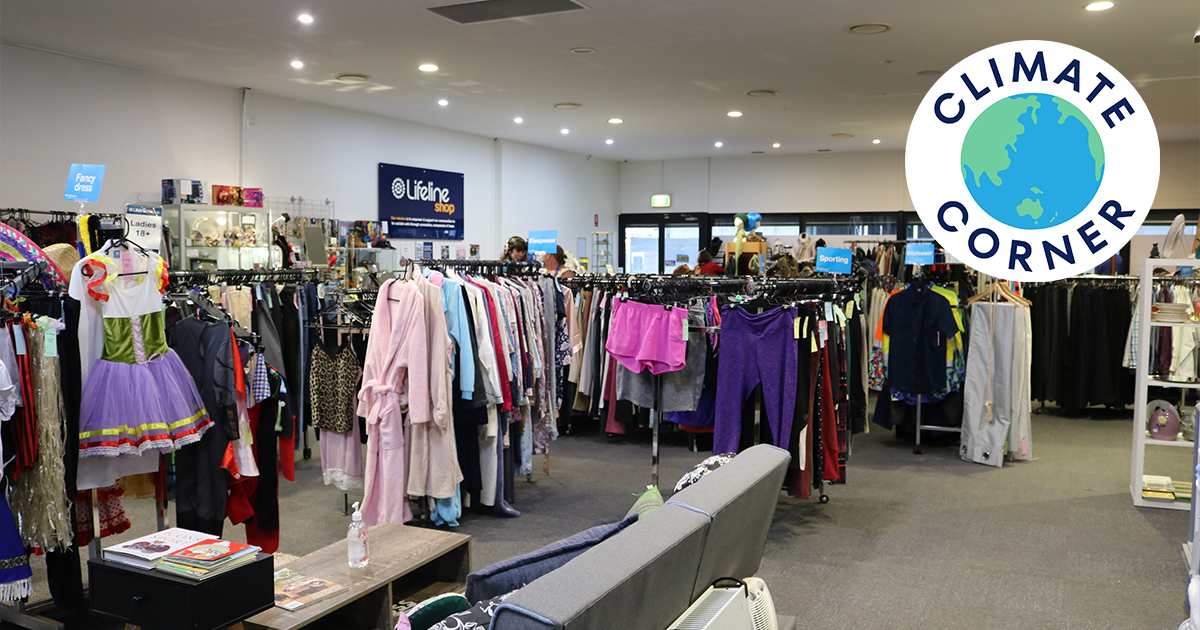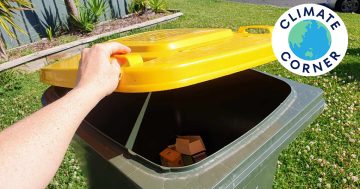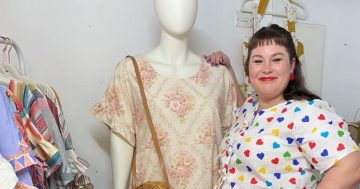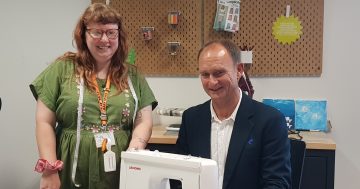
The first step on your sustainable fashion journey? Get familiar with local op shops. Photo: Region Illawarra.
The fashion industry is responsible for about 10 per cent of the world’s carbon emissions, and fast fashion is often singled out as the culprit.
Consumers are urged to buy less and buy quality – but what does that actually look like?
Elyse Stanes, a School of Geography and Sustainable Communities Fellow at the University of Wollongong, said it was nuanced.
“It’s one of those wicked problems, and it often opens a can of worms that leaves consumers with more questions than answers,” Elyse said.
“The sector is trying to convince us we can just recycle clothes, but in reality only one per cent of clothes can be recycled. Op shops are often overloaded.
“When it comes to textiles themselves, natural fibres are biodegradable, where synthetics can last for a couple of hundred years.
“It’s not as simple as natural good, synthetic bad though.
“Polyester can be recycled, and often bamboo will be mixed with polyester or acrylic to give it stretch for underwear or activewear.
“At the moment it’s really challenging to do anything with textiles that are a mix of synthetic and natural fibres, so it just goes to landfill.
“Cotton and wool can be very resource intensive to produce.
“Hemp grows quickly without a heap of resources, is much hardier than cotton, and doesn’t take a lot of energy to transform into a textile, but if it’s been brightly coloured with lots of synthetic dyes, that’s still having a significant environmental impact.”
So if we have to accept all textile production comes at a cost, and recycling isn’t the solution, what is the environmentally-minded consumer to do?
Elyse said reducing the impact our wardrobes had on the planet could be tricky – but it was not impossible.
Buying secondhand where you can is a good start.
Choosing clothes you will wear, and continue to wear, is the next step.
Because fashion is so personal, this is one area where it’s advisable to do your own research.
“Textile literacy is really important,” Elyse said.
“The best way to choose clothes that are high quality for you is to shop in person.
“We tend to conflate cost with quality, but that’s not always the case.
“Brands that are highly valued can charge a higher price for their product, but that doesn’t mean they’re any better in terms of fabric, construction or how they treat the people who make their clothes.
“On the other hand, you don’t think of Kmart as an investment because of the low price point, but if you take good care of some of their garments they can last years.
“Shopping in person gives you the opportunity to try things on, see how they fit, see how they feel, and check to see if there are any obvious flaws.
“If something doesn’t fit you well, or is uncomfortable, or doesn’t work for the purpose you bought it, you’re unlikely to wear it, regardless of the quality of fabric or construction.”
Textile literacy extends to how we care for our clothes after we’ve bought them, and is one of the biggest influences on how long a piece will last.
“We often bin clothes we like because they begin to get bobbles, have a small rip, or something itches,” Elyse said.
“We’ve got the wonderful convenience of a washing machine, but a lot of things aren’t made to just be chucked in.
“It’s worth taking the time to learn how to wash the clothes you have and make minor repairs.
“Alternatively, when you buy clothes you can make sure the item you’re buying will stand up to just being chucked in the wash.”
So, when we’re buying clothes we should try lots of things on, pay attention to how they sit and feel, and pay attention to the kinds of fabric we like and work well with our lifestyles.
Then when we bring them home, it’s worth taking the extra five minutes to clean them carefully.
Elyse said it was not necessary to wash clothes after every wear, unless they were particularly dirty, and reducing how often you washed your clothes could prolong their lives as well as reduce your overall carbon footprint.
They key takeaways? Buy less – Berlin and Australian researchers recommend less than five new items a year – wear more, and take care.
“To make an average T-shirt you need about six kilograms of carbon and 2700 litres of water,” Elyse said.
“That’s an awful lot of resources that have gone into a T-shirt for it to be worn 20 times.
“If you can wear that T-shirt say 80 or 100 times instead, then you’re really dramatically reducing the amount of pollution and water for each wear.”

















